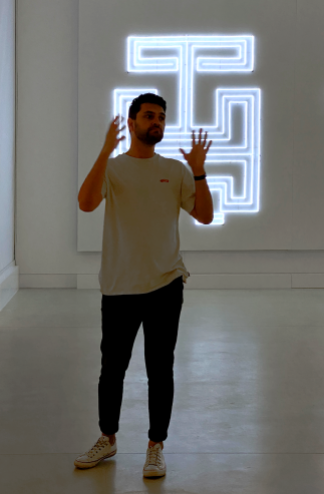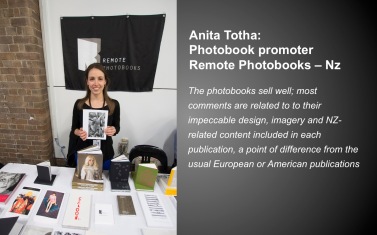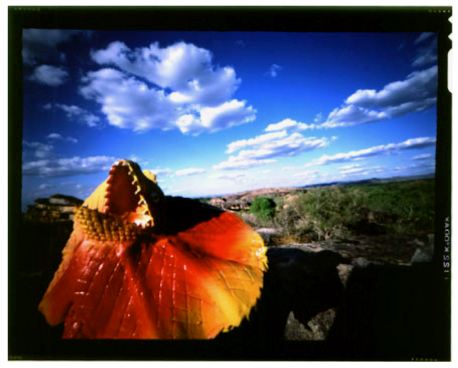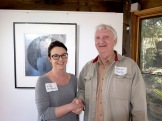Archive for the ‘Mail art’ Category
MARTIN HANSEN MEMORIAL ART AWARDS: Our Works
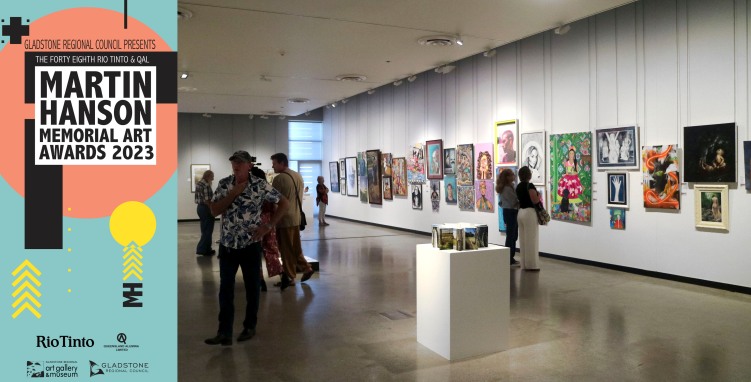
.
Once again we entered the Martin Hansen Memorial Art Awards at the Gladstone Regional Art Gallery and Museum. These Awards are the 48th event – Congratulations to the Gallery Team and the continued recognition of Martin Hanson’s early patronage of artists initiatives in Gladstone through these Awards.
For us each award entered is a place to present new works and their presentation – it is a challenge that hones our skills as artists.
.
This year Victoria’s entry was an artist book entitled String Theory Explained.
.

Victoria COOPER’s String Theory Explained presented
.Artist’s Statement:
String Theory Explained… its all about the unplanned and chaotic nature of everyday life… the beauty and terror within the order of “normal” existence.
.
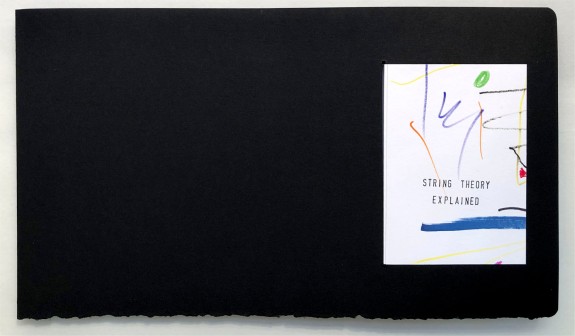
.
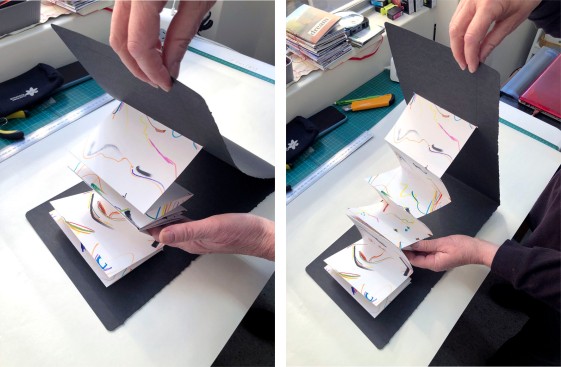
Opening up the book
.
Bibliographic Details:
Format: Concertina book embedded in folded cover
Media: various pen inks on art paper with Stonehenge black cover
Size: 764 x 230mm
.
.
Doug’s entry this year was Story Trees – First Nations a concertina artists book presented in a circular form.
.
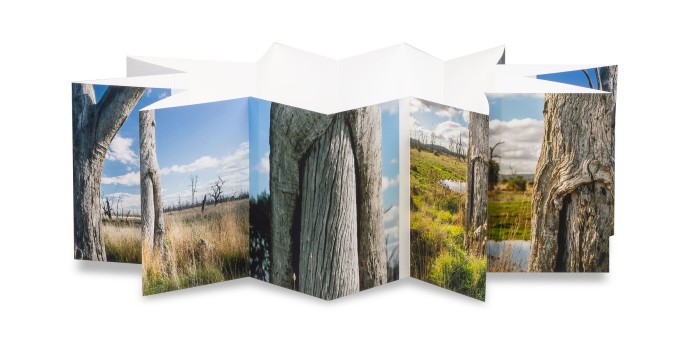
Doug SPOWART – Story Trees artists book
.
Artist’s Statement:
For me a poignant physical sign of First Nations presence remains embedded in the dead trees found throughout Mokoan. In witnessing these scar trees I found a profound sense of a time now passed and thoughts of the many stories that this place can tell.
This book was book two in a series of personal responses to encountering the locality of Mokoan and the Winton Wetlands. It was part of my contribution to the PALIMPSEST collaborative exhibition with Maggie Hollins and Victoria Cooper shown at Bainz Gallery in Wangaratta in August.
.
Bibliographic Details:
Format: Concertina book
Media: Pigment inks on photographic paper
Size in circular presentation: 600 x 700mm
.
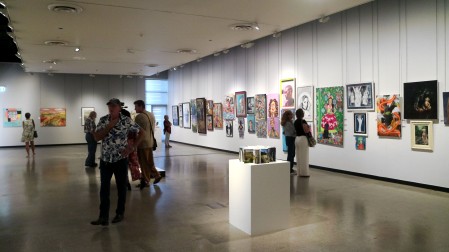
Doug’s Story Trees installed at GRAGM
.
.
The Martin Hansen Memorial Art Awards exhibition will be on show until 2.00pm on the 27th of January 2024 at the Gladstone Regional Art Gallery and Museum.
.
Here is some information about the 2023 Awards and the Entry Form.
.
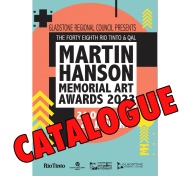 CLICK THIS LINK MH 23 Catalogue Online-r
CLICK THIS LINK MH 23 Catalogue Online-r
.
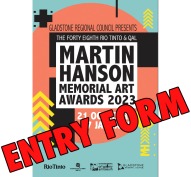 CLICK THIS LINK Martin Hansen Award 2023 Entry Details
CLICK THIS LINK Martin Hansen Award 2023 Entry Details
.
.
Photo of gallery installation courtesy of GRAGM
.
.
.
.
.
.
.
.
HOME: Our exhibition at GALLERY ON OVENS

.
WE NOW LIVE IN BENALLA in north-eastern Victoria, and to celebrate we held an exhibition at GALLERY on OVENS in May 2022.
.
A STATEMENT ABOUT THE EXHIBITION
Great writers, artists and philosophers have considered the physical, psychological, emotional and political place we call HOME. We reflect and are inspired by their work as we consider our personal perceptions of home personal within the broader human condition.
We have been artists and collaborators for over three decades. Our HOME has been: a house in a suburb or town, our car, a friends place, an artists in residence, a studio, a library, a campsite, a motel room. Whether stable or temporary the places we have inhabited – their architecture, history, social condition or collected objects have evoked our creative and questioning thoughts about perceptions of existence.
For us all these places we call HOME are spaces where we can contemplate, re-invent, conceive, originate, initiate new ideas for the future. We use the broad palette of our arts practice including – Camera obscuras, Cyanotype printing, Pinhole photography, Projections, Light painting and Nocturne light and the resolved artworks are presented as wall-images, artists books and photobooks.
.

COOPER+SPOWART – Home exhibition montage
.
.
In this post we report on the exhibition and the works it contained relating to the concept of HOME …
.
PREPARATION

Gallery on Ovens installation planning
.

Selecting work and preparing work
.
THE INSTALL
.
THE EXHIBITION

Table view of artists’ books

Gallery on Ovens window

Exhibition duo

Cyanotype wall

Looking at books with Maggie
.
THE DE MOUNT

The de Install
.
DOWNLOAD A “HOME” CATALOGUE – “CLICK” HERE

Catalogue Book Cover
.
.
.
.
Images and texts ©Cooper+Spowart 2022
.
.
.
OUR 2019 FIELD STUDY Submission: Tidal fire debris
Each year artists from around the world submit 100 copies of an artwork and mail them to an address in Geelong, Australia. Coordinator of the Field Study International mail art project David Dellafiora works with a team to collate and assemble the A5 sized artworks into books. Copies of the Field Study International are sold to collectors and institutional libraries around the world to raise funds for the workshop and to cover project costs. Contributing artists are also sent a copy.
.
This has been a great yearly project for us for over 10 years. What follows is the story of our submission for 2019. At the end of the post there’s a brief story about Dellafiora’s Field Study Projects. David is also involved in many other mail art projects… LOOK HERE
.
.
Surrounded by fire
Recently we drove through central western New South Wales and southern Queensland. The country was dry and hot with willy-willies and dust storms lifting and moving the precious soil across the landscape. There was little or no green and the dams were dry- even rivers that would normally have some water were just sand and dry dirt. Travelling on further we witnessed the great Brigalow forests of southern Queensland seemingly quivering under the heat of the summer sun.
.
Overall the country was brittle and broken from the endless dry. Not even summer there was a concern for the future as country towns not used to running out of water were in dire situations. Coastal areas where fire is a part of environmental regeneration there was also widespread concern for this now unusual extended periods of dry. This was not a normal cycle… The country was about to explode… all it takes is a dry thunderstorm with lightning, a careless smoker driving past or sadly a deliberate act from criminals.
So then the fires started so much earlier than expected… the many brave souls rallied to fight for their community. But these were not just the normal local bush fires… They grew and joined to form huge firestorms, the fighters used all they could find from buckets to the fire fighting trucks… But much of the land was inaccessible and many areas of forest could not be saved from the onslaught of wind and heat… Some forests that had survived through the millennia without fire in unique and protected ecosystems were now potentially changed forever.
We then came to stay at a friend’s family retreat on the coast of Northern NSW… The road to this place passes through huge areas of swamp and eucalypt forest that rarely burns as it is usually has good rain. But now we drove past kilometres and kilometres of burnt and dry country… We soon found that the regional area where our destination is located was surrounded by blackened country. The atmosphere, as with most of the coast in NSW was chocking with smoke and dust.
Even though we were assured that our town was safe these were not usual times and we felt uneasy and depressed by the enormity of this disaster.
We decided to dedicate our field report work to record this devastation. Our dismay was deepened when we walked along the beach and witnessed lines of leaves and twigs and other blackened material washed up with the tide .. like the dead bodies of victims discarded by criminals. Down the length of the entire coast of NSW where other fires raged, these waves of blackened and broken forests were appearing – the sea has returned the evidence to the place of the crime.
We began by gathering small samples of the material as symbolic references to vast amount of evidence left behind from these black tides. This Field Report is our first response as part of future substantive work on the contemporary condition of indifference, arrogance and ignorance towards a deteriorating environment.
Victoria Cooper
OUR SUBMISSION

COOPER+SPOWART 2019 Field Study submission
Signing the 100 prints…
.
SOME BACKGROUND TO FIELD STUDY REPORT
.
.
.
.
Look out for the 2020 Call for Submissions …
.
.
.
2018 FIELD STUDIES: CAMERA OBSCURA FERRY PORTHOLE – Bass Straight waves over the Spirit of Tasmania
As an important end of year ritual, we have once again prepared our submission to the ‘FIELD STUDIES INTERNATIONAL’ collaborative mail art project organised by David Dellafiora. Artists from around the world contribute to this project by mailing to David 100 artworks of any process and printed media made to A5 size. He then works with a team to collate all the submissions and assemble 100 copies of the collaborative book. After each participant receives one of these books, a number are then sold to private and institutional collectors to fund the project. We have contributed to the Field Studies for the last 10 years. Some links to the previous submissions are provided at the end of this post.
Here’s the story of our 2018 Field Studies report…
In 2000, we began a series of site-specific camera obscura projects that is a continuing body of work… This year we made two attempts to construct a cabin camera obscura. The second attempt proved more successful and so in this blog we present this recent work – Through a porthole in 3-5metre seas on the The Spirit of Tasmania.
On the morning of the 3rd of November we boarded the Spirit of Tasmania and checked in to our cabin for the nine-hour day crossing. We had booked months earlier and had requested a porthole cabin with the idea of making a camera obscura.
Earlier in 2018 we had tried unsuccessfully to make camera obscura images on an overnight crossing figuring that by the time we boarded the ship we would have a brief period of sunlight – alas, that would not be the case it was dark by the time we had boarded and checked into our cabin. This second time we worked it differently with a day crossing and a porthole cabin… we then prepared for a full day of camera obscura work.
You can imagine our excitement to find that our cabin was in the middle at the front of the boat with a view over the flagpole on the prow of the ferry to the sea beyond. So we set to work with a mini camera obscura tool kit had been prepared for the preparation of the darkroom:
- A quantity of heavy-duty black garbage bags
- Gaffa tape
- Scissors
Vicky documented Doug as he negotiated the space beyond the bunks to tape the black bags over the window. Progressively the room got darker and glimpses of the features outside our little cabin imaged themselves on the walls of the cabin. One problem was the darkening down of the central image area caused by depth of the room and a mirror on the reverse of the door. We decided that to create an observable image we needed re-purposed two white doona covers as a screen by taping them to the ceiling and walls with the gaffa tape. To recreate the theatrical space of the cabin camera obscura, we combined a series of images of the cabin walls and the screen at different stages of the journey. We also found our humble Olympus Pen camera set at ISO25,000 the best option as it fitted the small space and enabled hand-held exposures.
The Spirit of Tasmania left Devonport port and headed out into Bass Straight. For us this was a challenging crossing as there were strong westerly winds and huge 3-5 metre waves for most of the day. It wasn’t long before we began to experience the ‘bang’ and ‘splash’ of waves over our porthole… we were on one of the upper decks – deck 8!!! Kwells (anti-seasickness pills) were taken and to take our minds off the thump and roll we got active documenting the CO crossing.
Two composite images were constructed from our work that day that we entitled Through a porthole in 3-5 metre seas on the The Spirit of Tasmania. The first is a panorama that shows Vicky on her bunk looking at the projected camera obscura image. On the right-hand side the shadow of the camera held aloft is imaged. The final panorama is made of 4 images.
The second image is a triptych of the projected image on the screen showing a series of three photographs made by Vicky as the boat rocked with the centre image documenting a whiteout as a wave crashes on the window.
We left the camera obscura setup until we docked. Midway across Bass Straight the images described above we assembled and optimised as the ‘bang’ and ‘whoosh’ of the waves on the boat continued incessantly. At one stage we ventured out to see how those brave souls in the public areas of the ferry were managing… they all looked pretty green–some not well at all, and many finding any horizontal space they could to find some comfort.
When the Spirit docked we dismantled the CO and disembarked, glad to be on terra firma again.
.
.
.
To see a post about the FIELD STUDIES INTERNATIONAL and other of our Field Studies submissions
https://wotwedid.com/2013/01/05/field-study-international-our-contribution/
https://wotwedid.com/2017/01/17/field-studies-international-2016-our-contribution/
.
.
.
.
.
ZINES IN MELBOURNE: Sticky Institute’s Festival of the Photocopier
On Sunday 12 February the Melbourne Town Hall and was packed with sellers, lookers and buyers attending the Sticky Institute’s Festival of the Photocopier Zine Fair. At a guess, there could have been around 100 zine tables with a variety of zine-makers: both showing their own work, or representing other zinesters. For the visitor to the Fair there was an opportunity to see and handle almost any kind of communication that could put onto a sheet of paper, or into collated pages – folded, stapled, glued, stitched and sewn. Each ‘publication’ representing a personal approach to what the medium “zine” means to the author. And, as the ‘Zine’ is a slippery medium those within the discipline keep pushing the limits by integration of opportunistic technologies and ideas gleaned from contemporary media.
The content of the zines presented to us were from a broad church of visual and written media including: text as prose, poetry or as visual typographic forms, and calligraphy. There was a rich diversity of illustration from photo-realism to comic flat field work, photographs and even, in one sighted example – the ancient art of marbling. The narrative forms in these publications ranged from concrete poetry, prose, comic stories and disjointed stream of consciousness curated visuals.
In keeping with the tradition some zine makers aired their political opinions while others shared a fascination of contemporary everyday life. There were groups that concentrated on gender issues, music and issues of the street, while others presented dreamy naive and whimsical scenarios, adventures in suburbia, the road and outer space, nonsensical ghoulish and vampire episodes.
Our specific interest were zines based on or utilising photos sometimes referred to as photozines, as well as others that use photomontage in their narrative or conceptual work. Examples seen dealt with topics like the destruction of traditional family homes in the Chinese city of Guangzhou, skateboard stories, and a faux streetscape made up of photos of distressed buildings.
The Fair was a place to network. Greetings were made with like-minded people across the display tables and discussions took place about zines, life and art. We caught up with a few people we knew – David Dellafiora, Gracia and Louise and Glen Smith – Queensland’s zine hero Jeremy Staples was in the building somewhere but we didn’t get to meet. Zine-makers, or sellers, were keen to engage with us to tell the story of the work and where it fits with their practice and their life.
But did anyone sell anything? Many visitors were seen toting quite a few brown envelopes and calico bags filled with new additions to their personal collections. Perhaps a personal experience might shed some light on how success for such an event could be measured. It was right at the end of our shop, we had spent our budget and were talking to two young zinesters who were actually making their little photo zines on demand at their table. Their selling price was $3 and we wanted one of each but could only scrape together $5 in coin. One of the zinesters said ‘that’s fine, I’ll take the $2’, and stated that, ‘it’s important to have my zine out there…’
Being out there with your work. That is what zines are all about … your message in print as a democratic multiple … telling your story, was always what zines were about. That tradition it seems, continues…
Doug Spowart
February 13, 2017
.
SOME ZINES ADDED TO OUR COLLECTION
.
Trudi Treble – Instagram: trud.i
.
Glen Smith: https://nofrillsart.net/
Gracia and Louise: www.gracialouise.com
.
.
martinpf@hotmail.co.uk. Russiangluepress@gmail.com
Field Study – https://daviddellafiora.blogspot.com.au/
Alice Fennessy Instagram: @alicefennessy
Claire Wakeford: www.clairewakeford.com
Ning Xue: http://www.xuening.me/me.html
.
UNTIL NEXT YEAR …
.
.
Copyright in the zines is retained by the authors. All photographs + text + video ©2017 Doug Spowart
FIELD STUDIES INTERNATIONAL 2016: Our contribution
We have been busy the last few days completing our contribution to the 2016 Field Study International report project. Led by David Dellafiora in Geelong the Field Study project is now in it’s 22nd year. Field Study Report contributions are called emanations and can include all kinds of things including: ‘documentations of performances, actions and exhibitions, tracts, rants, instructions, manifestoes, reflections and experiments.’ They are a mashup of Fluxus, DaDa, Surrealist inspired, zine-ish paste-up, rubber stamps, torn up letter ransom notes and concrete poetry. The Field Study Report becomes a snapshot of artistic, social and/or political commentary at the time of its publication.
Our submission for 2016 is a commentary on our present nomadic lifestyle. Since moving from Toowoomba 2½ years ago we have been house-sitting, doing artists in residence projects, staying with friends and renting – we have lived in approximately 15 places.
For our submission we made a diptych of original cyanotype images recently while staying on the beach at Wooli. One print represents a starry night above a line of houses. The other print is a selection of of different keys –referencing all the houses we have stayed in. The two cyanotype prints were copied, scaled and arranged on the one sheet with the captions: ‘Keys to the homes where we have lived …’ and, ‘A Field Study Emanation for 2016 by Victoria Cooper + Doug Spowart’.
Each A5 print is numbered and signed and the edition is 100. Each contributor gets a copy of the assembled works and some copies are sold to support the project and the group that helps make it happen.
Submissions for 2016 are now closed however, get ready for 2017. For more information about Field Study and other projects see: https://daviddellafiora.blogspot.com.au/
About Field Study:
Field Study began in 1993 as a way of reclaiming the negative spaces between art and life. Activities stemming from Field Study are emanations and group emanations are manifestations. Field Study sees each work as a manifestation of a collective spirit. Everyone is welcome to become a member of Field Study, irrespective of their arts practice, and contribute to the Field Report. Field Study also produces the assembling publications WIPE and ReSite, and, in collaboration with Karingal, KART.
An earlier WOTWEDID Blog post has more detail… Check it out:
https://wotwedid.com/2013/01/05/field-study-international-our-contribution/
.
.
.
GEORGE PATON GALLERY: Artist’s Books (reprised) Exhibition
.
Digging in the archive: past and present
Artist’s Books (reprised) [artists’ books 1978-2014]: George Paton Gallery, University of Melbourne
Dates: 26 August to 5 September
A recent show entitled, George Paton Gallery, Artist’s Books (reprised), promoted that it would be showing “four decades of investigation into the possibilities and limitations of the artists’ book form.” Whilst the exhibition as presented had some gaps in the chronology, it did live up to its claim of presenting a significant collection of contemporary works alongside a carefully curated group of seminal artists’ book works from shows presented at the George Paton Gallery in the 1970s and 80s.
.
.
Visitors to the gallery encountered a space resembling a reading room with trestle tables and bookshelves presenting the contemporary books for viewing, handling and reading. Some books were marked as ‘white-gloved’ handling whilst the majority was available for direct tactile experience. Enclosed in vitrines were the historical books on loan from the University of Melbourne archives. Interestingly during the 1970s and 80s these books would have only cost a few dollars to buy but now they attract significant values. Included in this prized collection of books are: Ed Ruscha’s Small Flres and Milk; 1964; Marcel Broodthaers’ A Voyage on the North Sea; 1973; Sol LeWitt’s Grids – using all combinations of straight, not- straight and broken lines; 1975; Richard Long’s The North Woods, 1977 and Dieter Roth’s, Gesammelte Werke, Band 7, 1974. These books were sourced from past exhibitions held by the George Paton Galley: Artists’ Books/Bookworks from 1978 and Artist’s Books and Not (e) Book! from 1982, the latter curated by Canadian Tim Guest.
.
In all just over 100 books were available for viewing essentially coming from a ‘call out’ for artists book makers to present work for the show. There were some interesting names; Peter Lyssiotis, Theo Strasser, Sandra Bridie, mail artist David Dellafiora, zinesters Gracia Haby and Louise Jennison, and photo-newspaper publisher Jacob Raupach. Anyone with a preconceived idea of what an artists’ book is, or should be, may have been challenged by some of the works in the show – but what an experience it was to be challenged in that way. It was a rare opportunity to view and compare such a diverse and historical collection of artists’ books.
.
After spending a couple of hours in the exhibition space I searched for a way of describing the show. Then I found a text that offered a perceptive critical evaluation of the artists’ book genre. Some relevant passages from this text follow…
.
Artists’ books can most simply be described as those books which have been conceived, designed and produced by visual artists. As distinguished from those books about artists, such as a monograph of catalogue raisonee, or about art, artists’ books are instead complete artworks in themselves: they are artworks that are presented in the form of books.
Since about 1960 a distinct genre of artists’ books has appeared. These are by artists who are self-consciously exploring the possibilities of printed books: the social dynamics of a reproducible vs. a unique art object; the aesthetics of the mass print media vs. fine art prints or deluxe editions.
The contemporary genre of artists’ books is now a widespread phenomenon. Practically every significant development in western art has been reflected in the ongoing publication of artists’ books. There are books coming out of the movements of pop art, minimalism, arte povera, performance art, fluxus, happenings, and new image painting. Conceptual artists of the 1960’s and 70’s in particular, utilized the book form as a method of realizing artworks. We can regard these books now as a vein which runs through many areas of contemporary art and includes diverse movements, interests and preoccupations.
Or have the interests been so diverse? Pop art, minimalism, performance art, arts provera, were all movements distinct from (even antagonistic to) one another, yet they all belonged to a general tendency towards “non-objective” art… Briefly, this tendency has been reflected in a desire on the part of artists to explore new media, in an attempt to abandon the traditional (modernist) disciplines of painting and sculpture. It was/is in favour of the widened scope of the flux and flow of a multi-disciplinary approach. For example, an artist may be involved in sculpture as easily as film, performance, video, photography and/or books. Perhaps most significantly there has been a conscious determination to undercut the reification of artworks – society’s valuation of art – by concentrating on the non-objective. This has meant, for instance, producing works from common industrial or throw away materials (art povera, fluxus), works constructed only in theory (conceptual art, language art), imagery stolen from the banal repertoire of mass media (pop art) ….. All this seems to have been more successful as an ideal than as an actual practice. Minimal sculpture in the late 60’s was quite successful in the art marketplace. Conceptual art has been immensely influential, popular, and saleable. As much as these artworks were determined in opposition to the bourgeoise reification of art they were inevitably complicit with it. That is because capitalism is a social system which seems to embrace new ideas but in fact appropriates and establishes a commercial value for then.
Artists’ books typify this interest in non-objectivity and reflect the internal contradictions of such an ideal in a particular way. In contrast to the traditional “livre d’artistes” of deluxe editions, artists’ books are usually inexpensively produced and sold. They are affordable, accessible and as plebeian as an art object can be. In fact they are almost too exemplary of the non-objective ideal.
As books they are not commercially viable simply because they defy the expectations of a mass market by presenting avant-garde information. Yet they have few patrons in the art world because their affordability to the public represents a low profit for a dealer. Also, books can not [sic] be viewed in the same way as other art objects; they must be held in one’s own hands and read. It is remarkable then that despite the contradictions and foils of art’s survival, artists’ books have become such a highly evolved genre of contemporary art, as evidenced by the works in this exhibition.
.
To illustrate means to make something clear by example, or to adorn a book with pictures. Within a publication, an illustration can be a picture, a drawing, a photograph, a design, or an ornament. Illustration is, of course, a prominent element in all mass media publishing. To consider all illustrations as a single genre is, in a way, quite boggling. It means imagining all magazines in the world and all the printed pictures.
With this imagining I try to analyze these pictures but have only an individual response to guide me. In principle my inquiries and suggestions are all subjective, my curiosity is intuitive, my critical remarks are speculative. These habits of mind and predilections constitute the trail of my argument. Because illustration operates as such an enormous social phenomenon, it is difficult to grasp its total meaning as a genre. It is too huge a concept. Yet paradoxically, all is intimately familiar.
Practically everyone looks through magazines, sees the pictures, knows what they mean. But try to separate yourself from a simple recognition of the picture and examine the picture as a conceptual model and you may understand how difficult it can be. An illustration is not simply a picture of an object or thing. In that object’s absence a picture is a way of visualizing it, recalling it or conjuring it. Then all together the medium of illustration is a way of visualizing the world. As illustration is a mass medium, it is certainly a very powerful and influential instrument of ideas. As a conceptual model, a picture is showing us how to think and what to think about.
Art characteristically departs from conventions. In leading the way from these conventions and artists can end up revealing and/or inventing upon a given culture, popular or otherwise. Furthermore, the artists’ books in this exhibition occupy a middle ground between the hermetic region of high art and the mass culture of popular illustration. They also embody a comparison between the two; they have been produced as a way of participating (in theory at least) in the mainstream of popular culture at the same time as they are an extension of art, extending beyond galleries and museums, and outside of the realm of the rarified art object.
It may be noted that the photo works included in the exhibition are not photography books in the usual sense. For example in some books, the artist has exchanged the customary fine detail and high quality printing found in most art photography books for the flat, grainy, aesthetic of newswire or snapshot photographs, with all their vernacular associations. In other books the artist may manipulate the photographic frame by cropping it tightly to draw attention to narrative details or expanding it to the edge of the page for a window effect. Some books here constitute a repertoire of personalities through a wide array of photographic self-portraits. Others are collections of images specific thematic subject matter which suggests an interpretation of the complex meanings of culture and its institutions through the examination of its artifacts.
.
In opposition to the conventions of art photography, which dictate an aesthetic around the “integrity” of an individual print, these photo books, to some extent, are each engaged with the qualities inherent in reproduction by offset and other printing processes. The artists represented in this exhibition are utilizing photographs as something other than a clear, well-composed picture. In their books they manipulate the “natural reality” of photographs and so inform our recognition of photographic images with their mannered inventiveness.
There are also a few books included here which are constructed sculpturally to introduce a tactile sensation to the fingertips and so expand the act of reading illustrations into the field of sensory awareness.
.
Finally, just as the works in this exhibition are included towards an exploration of the social and aesthetic attributes of illustration, they also demonstrate a way of looking at and experiencing the world. Theses artist’s books reveal and embody a way of reading deeply into they dimensions of contemporary culture. As much as they foster an incipient consciousness they ask for sensitivity on the part of the reader.
.
These words come from Tim Guest, the curator for the 1982 George Paton Gallery Artist’s Books and Not (e) Book! A copy of his catalogue for the show was made available at the exhibition. Guest’s commentary is as relevant today as it was in the early 1980s, and while we have moved on, and now view the artists’ book works of that time with a degree of comfort and acceptance, the new artists’ book works continue, as Guest points out to, ‘demonstrate a way of looking at and experiencing the world’. For me it emphatically confirms that artists’ book are still ‘edgy’ and still pushing limits.
Doug Spowart
September 5, 2014
DOWNLOAD the contemporary list of artists’ books gpg artists books list of works
DOWNLOAD the books on loan from the University of Melbourne ArtistsBooksloanselectionGPG2014 docx
.
.
Part of the associated activity for the show – an artists’ book making event outside the gallery led by Michele and Laine. It was a a sunny and warm late winter’s day in Melbourne.
.
.
.
.










